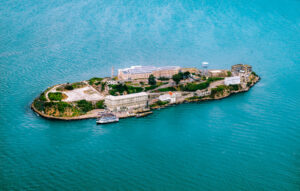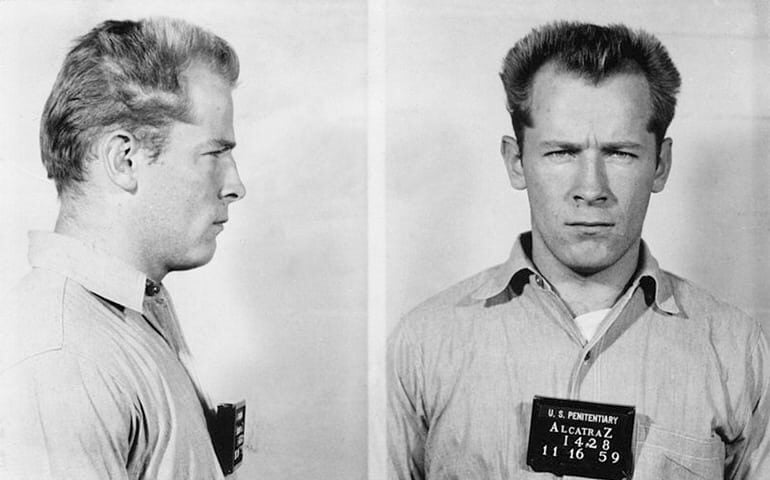Featured in this post
Keep Exploring
San Francisco, CA
Essential San Francisco
Explore More
In the annals of organized crime, the story of James “Whitey” Bulger is the stuff of Hollywood. (More on that in a minute.) He started out as a bank robber in the 1950s, earning him a stint at Alcatraz, before rising in the 1970s to be the head of a vicious gangland empire in Boston. That’s also when he became an informant for the FBI. (He gave the feds tips on rival gangsters.) In 1994, Bulger went on the lam after learning, via his FBI handler, that he was about to be indicted on federal racketeering charges.
He was 81 when authorities finally caught up with him in 2011. Bulger had been living out his sunset years in a quiet apartment complex in southern California. The notorious gangster was found guilty of 11 murders and later killed in prison by other inmates in 2018. Since then, more details of his infamous life of crime have emerged–shedding light on everything from his time at Alcatraz to his relationship with the FBI.
He Was Known as “Jimmy” Before “Whitey”
James “Whitey” Bulger, 1428-AZ, was no ordinary criminal. When he arrived at Alcatraz in 1958, the soft-spoken Bulger, known as “Jimmy“ to fellow cons, didn‘t stand out as the man who would become the Al Capone of his era.

Bulger has been the subject of numerous major Hollywood films and documentaries. Famed director Martin Scorsese used Bulger’s persona as the model for the central character in his film The Departed, the Academy Award winner for Best Picture in 2007. “In no way do we say that Francis Costello [played by Jack Nicholson] is directly patterned after Whitey Bulger,” Scorsese later noted in an interview. “But let me put it this way: we felt comfortable in the character because we knew it to be true.”
By the late 1970s, Bulger had become the principal figure of the Winter Hill gang, the preeminent Irish American crime syndicate in the Boston area. He stood at the top of Boston‘s criminal underworld for nearly three decades without ever being charged for even a misdemeanor crime.
From Boston to Books and the Big Screen
In bookstores, true crime sections are typically dominated with works chronicling his life and crimes and in movies he is depicted as a hands-on enforcer who ruled the streets of Boston and beyond. Bulger grew up in the tough South Boston housing projects and, as a youth, he idolized the bigger–than–life Hollywood bad guys played by James Cagney, Edward G. Robinson and George Raft.
Despite the numerous books and movies on Bulger‘s life, what‘s often overlooked are the formative years he spent on Alcatraz closely watching mafia moguls, like Mickey Cohen and Bumpy Johnson, that he served time alongside on the Rock. For the young Bulger, Alcatraz was a front row seat to the highest stratum of crime figures and how they conducted themselves walking among peers. He also was witness to one of the greatest prison breaks of the 20th century. His role in the famed 1962 escape of Frank Morris and the Anglin Brothers would become a training ground for understanding what it would take to successfully disappear while on the run from authorities.
How Did Bulger End Up at Alcatraz?
Bulger’s path to Alcatraz was paved with a series of bank robberies that began in Rhode Island. Clutching a pistol in each hand as in the style of an old west outlaw, Bulger would hold aim on bank employees while his accomplice Richard Barchard scooped the cash into a bag. Then both would flee to a stolen getaway car that was driven by Barchard‘s wife Dorothy. The car was then driven to a nearby parking lot, where they switched into another car where Bulger‘s girlfriend waited for them. A nationwide manhunt by law enforcement brought the men and their accomplices to justice. By the time Bulger was finally captured on December 2, 1955, in Miami, Florida, the heists had brought in more than $100,000 in cash.
Bulger received a 20–year sentence and was initially sent to the United States Penitentiary at Atlanta, Georgia, in July of 1956. The years in Atlanta were tough with Bulger participating in medical trials for Malaria treatments and later the CIA’s infamous (but then secret) MK-Ultra LSD research program that would fall under public scrutiny for the brutality it imposed on human subjects. Prisoners received good time credits off their sentence for their participation.
But the incorrigible Bulger participated in various failed prison escapes that landed him in solitary confinement.
On October 21, 1959, Bulger‘s official transfer order to Alcatraz was issued and he arrived less than a month later as 1428-AZ.

James “Whitey” Bulger’s Alcatraz Experience
Bulger‘s first cell, C-145, was located along the main corridor of Broadway. It was here standing at the bars that he would meet Clarence “Joe“ Carnes who passed along messages from several friends who had already made their way to the island. Carnes and Bulger were to become good friends during his tenure on Alcatraz. In December, he moved to the top tier of C Block to C-314 where he mostly remained for his years spent on the Rock. The upper section of C Block was a coveted area. It was on the top tier where prisoners could hear well in advance correctional officers ascending the stairs during routine and surprise inspections. The cells along this corridor faced the sprawling cement wall of D Block and those on the upper tier where Bulger lived had the brightest and warmest cells as the rays of bright sunshine gave warmth to an otherwise dismal landscape. Bulger read extensively from the Alcatraz library and loved many of the classics, particularly the western adventure novels by Zane Grey.
On Alcatraz, Bulger held several prison jobs, including working in Clothing Issue in the cellhouse basement, and then on October of 1960, he took a job as part of the cellhouse maintenance detail. (He mentored one new arrival, John Anglin, who was to later take part in one of the most famous prison breaks in American history.)
Following his maintenance assignment, in December of 1960, he took a new job in the prison laundry working under an officer A.G. Bloomquist. Nicknamed “Bloomie“ by fellow prisoners, it was here that the typical guard versus prisoner stereotype vanished, and a close friendship ensued.
Bulger later noted that once the day‘s work was completed, Bloomie allowed the men to work out and talk amongst each other. Bulger admired him for being respectful and trusting of the convicts and never abusing his power over them. “The respect for Bloomie rose to such a level among the prisoner population that there was unspoken code among the men that in the event of any escape attempt,” Bulger later noted in an interview. “Bloomie would not be harmed. For me, he became a trusted friend even following my release from prison.”
Another prominent figure to Bulger was Mickey Cohen, 1518-AZ. He arrived on Alcatraz in July of 1961, and Bulger later acknowledged that he admired Mickey and how he held himself in the company of fellow cons. Cohen often gave the young Jimmy Bulger a nod as they passed each other in the cellblock during meal periods and when he‘d pick up his weekly clothing issue. Cohen mostly kept to himself but was respectful to everyone no matter of race or criminal affiliation, including officers. “Mickey was a proud little guy and a survivor,” Bulger later commented. “He was very well liked by all the guys at Alcatraz.“

Bulger was also a close insider to the 1962 Alcatraz escape of Frank Morris and the Anglin brothers. Having struck up a friendship with Morris in Atlanta, he helped offer advice on the best methods for not only the mechanics of the escape, but also how to avoid being captured during their years of freedom. It was during those discussions that Bulger credited them for helping him learn how to evade capture for more than sixteen years. The key, he later said: “In order to survive, I understood the importance of breaking all contact with loved ones and holding to that level of discipline. It was tough…we all knew the penalty that would fall on the innocents we cared for. You have to factor that into as to why they were never seen or heard from again. Freedom came at such a big price, but it was still better than the long and lonely years spent in prison.“
Indeed, the famed escape that Bulger witnessed would have a huge impact on him. It was also a profound event that many believed help close Alcatraz. “The morning of the escape was one of the happiest moments of my life,” Bulger later said. “When the frantic guards realized that Morris and the brothers had escaped, the cheers were so loud that it could be heard for miles! As far as I‘m concerned, it was the greatest escape in the history of the U.S. and achieved under the most extreme security measures.”
James Bulger was transferred off Alcatraz in July of 1962, only a month following the great escape from Alcatraz. He was released from prison in 1965 and federal prosecutors would later say that Bulger led south Boston‘s Winter Hill gang from the late 1970s through the mid-1990s, when they were one of the most powerful crime syndicates in the United States. In 1975, Bulger made a deal with the FBI, in which he agreed to provide information about the Italian American Mafia in exchange for protection from prosecution.
Bulger Becomes FBI Informant
In January of 1995, Bulger’s FBI handler and friend from childhood tipped him off that an arrest warrant on racketeering charges was forthcoming and it was a matter of time before several mafia–related murders would be attributed to him, resulting from plea deals made my other former associates. Bulger would disappear for nearly sixteen years despite one of the most aggressive fugitive manhunts in history.
On June 22, 2011, the FBI caught up with Bulger and his girlfriend, Catherine Greig, holed up in a modest Santa Monica apartment building on the coast of southern California. At the time of his capture, he had risen to number one on the FBIs “Top Ten Most Wanted List.“

Even in his later life, Bulger always looked back at his years on Alcatraz with nostalgia. When looking through books chronicling the island’s history, he likened it to browsing through an old high school yearbook. The memories were bittersweet. Tough years with solid friends. He held the men of Alcatraz in high regard and when he later learned of “Joe” Carne’s death and burial in an unmarked paupers’ grave, Bulger had him exhumed and reburied him in an expensive casket, with a proper ceremony.
Before Bulger went on the lam in 1994, he had visited Alcatraz with his then girlfriend Theresa Stanley. They walked through his old cell block, where he reminisced about his years on the Rock. For many of the men imprisoned at Alcatraz, it was the end of the line. But for James “Whitey” Bulger, Alcatraz was just a short and influential stopover in his long criminal life.
Tour the Island and the Prison with Alcatraz City Cruises
You can explore where James “Whitey” Bulger, and many other notorious criminals, called home while serving his time with Alcatraz City Cruises! With multiple tour options to select from, there is something for everyone. Favorites include the Alcatraz Day Tour, which includes a round trip ferry ticket to the island, with admission to Alcatraz Cellhouse. Or check out the Alcatraz Behind the Scenes Tour, where visitors will be able to discover areas that are otherwise not available to the public. This 4-5-hour tour will take you all around the off-limit areas, before joining up with the Alcatraz Night Tour.
Original Post Date: September 10, 2018
Featured in this post
Keep Exploring
San Francisco, CA
Essential San Francisco
Explore More


